ATNF Science Highlights 2001
First observations of SNR 1987A at 12 mmThe 1987 supernova in the Large Magellanic Cloud, SN1987A, the brightest supernova of the last 400 years, was one of the first objects observed with the upgraded Compact Array at 12 mm. Monitoring at centimetre-wavelengths showed a gradual decline of brightness, which quickly fell below the detection threshold of radio telescopes. In 1990, radio emission was again detected and has since increased continuously, marking the birth of a supernova remnant. With the Compact Array at 3 cm, SN1987A's diameter of 1.6 arcseconds is barely resolved, and only sophisticated image processing techniques were able to reveal some detail of the remnant. However, at 12 mm, the Compact Array easily resolves the nebula, with a resolution comparable to that of the Hubble Space Telescope and the Chandra X-ray satellite. This observation will contribute important insights to the understanding of this system. read more |
 |
HIPASS J0352-66: a nearby galaxy forming its first stars?A recently discovered cloud of neutral hydrogen with an almost invisible optical counterpart is an enigma for galaxy formation and evolution. A discovery of the HI Parkes All Sky Survey (HIPASS), the cloud was thought to coincide with the giant elliptical galaxy NGC 1490, and was imaged in detail with the Compact Array. Surprisingly, the HI emission turned out to be offset from NGC 1490 and to apparently freely float in space. The cloud, HIPASS J0352-66, has a size comparable to that of the Milky Way, but has only just started to form stars. The neighbouring elliptical NGC 1490 turned most of its HI gas into stars a long time ago, and the diversity of star forming processes in such a small volume of space is unexpected. It is possible that HIPASS J0352-66 has only recently begun to form out of intergalactic gas, something which has important consequences for the distribution of matter in the universe. read more |
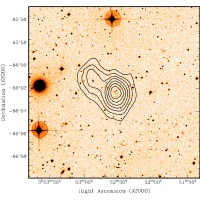 |
Polarization in methanol masersOH masers provide an opportunity to study accretion processes in star-forming regions. However, to date no source exists in which such an accretion disk has conclusively been found. Polarization properties can help to understand the physics in the masing regions. The masing molecules align in external magnetic fields and hence the emission carries a fingerprint of parameters such as the magnetic fields and the density of the emitting regions. Knowledge about the magnetic field strength and structure is essential in understanding star formation processes and, as magnetic fields in circumstellar accretion disks are expected to be well-ordered, one should be able to measure the polarization of masers. The Compact Array was used to make the first full polarization observations of 6.7-GHz methanol masers in four sources, and a typical degree of linear polarization is 2-3%. Showing up to 10% of linear polarization and coinciding with an ultracompact HII region, G339.88-1.26 is one of the best methanol maser disk candidates, although the details of the system need further investigation. read more |
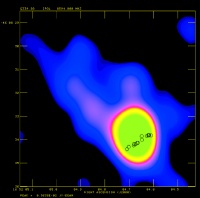 |
Searching for neutral hydrogen in groups of galaxiesGalaxies mainly come in smaller or larger groups, and these groups are an important piece in the puzzle of the Universe's structure. The smallest kind of groups are the loose groups, with a few spiral galaxies and some dwarf galaxies, and typical separations of 100,000 parsecs. The Milky Way is part of such a loose group known as the Local Group. It is a 30-year old suggestion that the Milky Way is surrounded by fast-moving clouds of neutral hydrogen (HI), the High-Velocity Clouds, or HVCs. HVCs have been suggested to have distances of about 1,000,000 parsecs, hence their gas should be "old" and its composition be comparable to that soon after the Big Bang. Other loose groups also should have similar HVCs, and observations of two such groups, LGG 93 and LGG 180, have been carried out with the Parkes telescope. In LGG 93, four new HI clouds with 10-100 million solar masses were found, only one of which was optically identified. In LGG 180, three new detections were made, all of which could be identified with optical counterparts. Optical observations are now needed to place limits on the stellar mass content. read more |
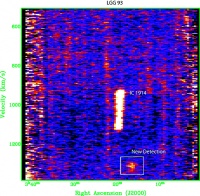 |
The magnetic field of barred spiral galaxiesThe so-called "bars" in spiral galaxies are thought to play a role in the motion of gas, and hence in the galaxy's star formation. Magnetic fields follow the gas motions, and polarization measurements can help to determine the magnetic field properties. A study of 20 barred spiral galaxies with the Very Large Array (VLA) and the ATNF's Compact Array yielded detections of polarized emission in 17 of these objects. It was found that the radio surface brightness and the rate of star formation in spiral galaxies are highest for galaxies with a high content of molecular gas and with a high quadrupole moment of the bar's gravitational potential. Also, the magnetic field structures turned out to correlate with the radio brightness of the galaxies. read more |
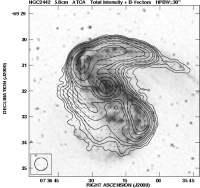 |
PKS 1257-326: a scintillating quasarSome extragalactic radio sources exhibit a rapid variability of their radio flux density, and a subset of these also shows variability in other bands. This may be intrinsic to the source. The radio variability, however, may also be a scintillation effect in the foreground interstellar medium (ISM) of the Milky Way, and the question is which of the two mechanisms is actually at work. A detailed monitoring of one of the most rapidly variable sources, PKS 1257-326, now has shown that the variability pattern follows an annual cycle, clearly indicating that the variability is connected to the earth's motion around the sun, and hence its motion relative to the ISM. The variability is fastest when this speed is high, i.e., when the earth and the ISM move in different directions, whereas the variability is slow when they are moving in similar directions. The variability study can also be used to derive the size of the source (no more than a few tens of micro-arcseconds) and the distance of the screen (less than 100 light years). read more |
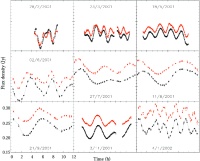 |
On the trail of gamma-ray burst progenitorsEvidence has recently emerged that gamma-ray bursts, the most luminous events in the universe, are most likely to be connected to supernovae, the death of massive stars. The basic idea is that a black hole is formed during the collapse of the evolved star, and that this black hole ejects collimated beams of matter along its rotation axis. These beams encounter pre-burst material which has been released in shells from the surface of the dying star. Arguments in favour of this model arise from the observation that all gamma-ray bursts seem to occur in star-forming galaxies and that large amounts of matter dim the visible light, resulting in "dark" gamma-ray bursts. If gamma-ray bursts actually occur in supernova events, then one would expect to see the signature of the circumstellar shell imprinted on the radiation from the event, and one would also expect to see the typical light curve of a supernova. The relatively nearby gamma-ray burst GRB 011121 provided an opportunity to test these hypotheses. Optical observations showed the light curve of a type Ib or Ic supernova, and radio observations with the Compact Array ruled out any afterglow model except the jet model expanding into the stellar wind shells. read more |
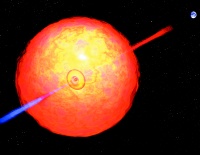 |
